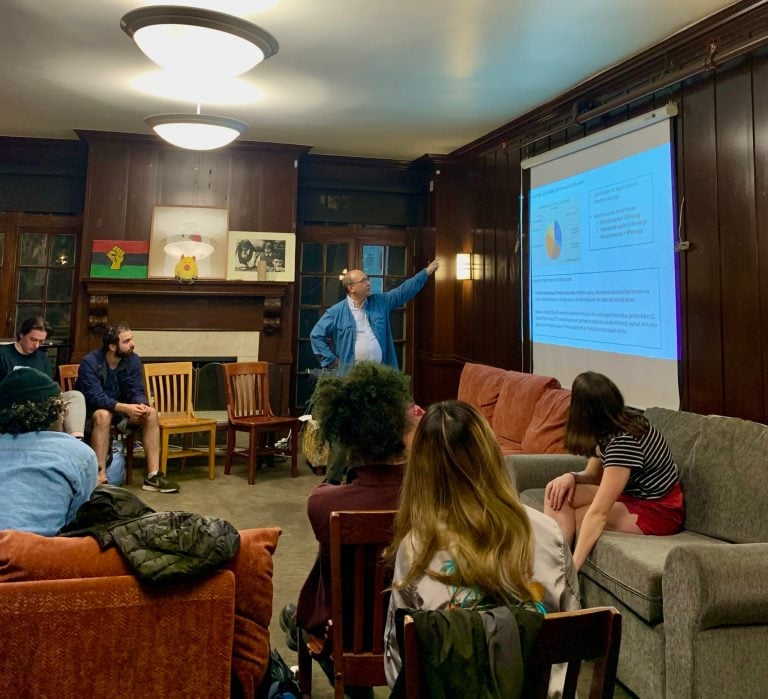Fossil Free Stanford kicked off a “week of action” on University-wide divestment activism with a faculty-led teach-in that cited insufficient transparency and accessibility of the Board of Trustees as the largest obstacle to meaningful change on divestment.
The teach-in, held in Columbae House on Monday, featured educational presentations by environment and resources Ph.D. candidate David Gonzalez M.S. ’18 and public policy and urban studies lecturer Larry Litvak, followed by a panel of student activists.
While Fossil Free has been actively pushing for divestment from fossil fuels at Stanford since 2012, the four undergraduate student panelists accused the Board of Trustees’ of opaque internal processes and delayed scheduling issues stood in the way of divestment activism.
The University has not responded to The Daily’s request for comment.
Zoe Brownwood ’22 said that Fossil Free has only been allotted one hour-long meeting with the Board of Trustees in the past 10 months, despite repeated attempts to get in touch with the Board. Their follow-up meeting will take place Tuesday.
Associated Students of Stanford University (ASSU) President Erica Scott ’20 cited mismatched incentive structures and timelines as the biggest challenge in bringing the divestment cause to the Board of Trustees. Students hope for immediate action while the Board tends to delay addressing divestment issues, she said.
Justin Wilck ’20 spoke to what he described as the frustrating structure of student divestment activism, emphasizing that the process requires an immense amount of labor on the part of students that is often ignored or disregarded by the Board.
The students said that their ultimate goals extended beyond cutting Stanford’s financial ties with harmful companies to making ethical investments. According to the student panel, ethical investment would allow the University’s financial holdings to reflect its community values, with limited negative financial impact.
“Based on our research, ethical investment is not less profitable,” Scott said.
During his presentation, Litvak focused on the history of the divestment movement at Stanford, advocating for divestment as a powerful tool.
He defined divestment as excluding investment of a particular type, and outlined the three major categories of divestment: moral, political and financial.
The student-led divestment movement took off in the late 1970s, catalyzing a 1977 sit-in that led to the arrests of nearly 300 Stanford students who demanded that the University divest from apartheid South Africa. Litvak credited Stanford’s movement as a precursor to the growing popularity of divestment campaigns on college campuses.
In 2014, Stanford divested from coal-mining companies, its first major divestment from fossil fuels.
“Stanford was the first major institution that divested from coal,” Litvak said.
While Litvak lauded the move as a good initial step, he noted that Stanford does not report the details of its investment holdings, so it is difficult to know the current state of the University’s financial portfolio.
Gonzalez focused his teach-in presentation on the community impact of fossil fuels. The drilling of fossil fuels often takes place in communities that are already minority and low-income, according to Gonzalez. Latinx and Hispanic communities in particular, he explained, are disproportionately proximate to drilling sites, and many are within two kilometers of an oil well.
“The industry wants to be able to drill where they want to, and this happens to be minority, Latinx communities,” he said.
An epidemiologist by profession, Gonzalez researches the health effects on infants living in communities impacted by oil refineries and other fossil fuel extraction industries. Gonzalez cited increased pollution and chemical exposure as being responsible for increased reproductive and respiratory health issues in these communities.
“We are fighting tooth and nail to get minimal protections … and that’s just in California,” Gonzalez said in regard to legislating protective policies for these at-risk communities.
Gonzalez also said the fossil fuel industry conducts intentionally misleading studies. He cited a Shell study that found no correlation between proximity to an oil well and infant health risks, noting that the study examined communities as far as 200 kilometers from the well site.
All teach-in speakers urged Stanford to follow the actions of other major universities, such as the University of California system and Georgetown University, and commit fully to fossil fuel divestment.
Sophia Manolis ’23, who was involved in planning Fossil Free’s week of action, emphasized that encouraging student activism and providing informative resources was a major goal of the teach-in.
Beyond raising more awareness towards the divestment cause, Manolis outlined Fossil Free’s concrete goals for the week of action.
“One of our goals is to appoint a student to the Board of Trustees’ [Committee for Investment Responsibility] since there is currently not a lot of student representation,” she said.
Other major goals include holding a divestment town hall and receiving public support from University President Marc Tessier-Lavigne.
This article has been corrected to reflect that Stanford did not divest $18.7 billion of stock from coal-mining companies. That was the value of the University’s endowment at the end of the 2013 fiscal year. The Daily regrets this error.
Contact Esha Dhawan at edhawan ‘at’ stanford.edu.
